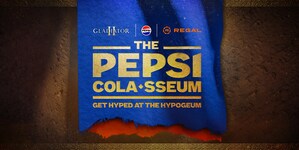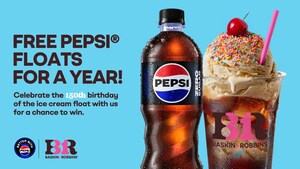NEW YORK, Feb. 9, 2012 /PRNewswire/ --
- Plans to increase advertising and marketing support behind its global brands by $500-$600 million in 2012, with particular focus on North America; going forward, it expects to maintain or increase that rate of support as a percentage of revenues
- Multi-year productivity program expected to generate $1.5 billion of incremental cost savings by 2014 through optimization of operating practices and organization structure, including a reduction in force of about 8,700 employees, about 3 percent of global workforce
- Company targets high-single-digit core constant currency* EPS growth for 2013 and beyond after a transition year in 2012, in which it expects core constant currency EPS to decrease by 5%
- Announces plan to increase returns to shareholders in the form of higher dividends and share repurchases in 2012
PepsiCo (NYSE: PEP) announced today a series of strategic investment and productivity initiatives to deliver top-tier, sustainable long-term growth for its shareholders. These decisions are based on a comprehensive review by the Company's management of its portfolio, brands, costs, organization and capital structure. As a result of its review, the Company reaffirmed its commitment to an integrated food and beverage portfolio through a one-company platform.
(Logo: http://photos.prnewswire.com/prnh/20111212/NY20842LOGO )
"In a volatile global environment over the past five years, PepsiCo has delivered double-digit compound annual growth in core net revenue, 8% compound annual growth in core EPS, and returned about $30 billion to shareholders in the form of dividends and share repurchases," said PepsiCo Chairman and CEO Indra Nooyi. "Our goal is to continue on that earnings trajectory over the next 5 to 10 years, fully recognizing that we need to make changes in how we operate to address the challenges we identified in the review process. 2012 will be a transition year, in which we will be taking the appropriate steps to build a stronger, more successful company going forward."
James Schiro, PepsiCo's presiding director, said: "The Board of Directors has been engaged throughout the review process. We are fully aligned with and supportive of management with respect to both the strategic direction of the Company and also the initiatives being announced today."
Senior executives will share details of the Company's strategies at an investor meeting at 8 a.m. (EST) today. The meeting, including a slide presentation, will be webcast live on the Company's website at www.pepsico.com/investors.
Key Initiatives
The Company reaffirmed the underlying strength of its integrated food and beverage portfolio -- and concluded that PepsiCo offers the most compelling value to shareholders as one company.
Beginning in 2012, PepsiCo is undertaking a number of key actions to further strengthen the Company and enhance shareholder value. The Company said it plans to:
- Significantly increase investments in its iconic brands and in bringing innovation to market. Advertising and marketing spending will increase by $500-$600 million in 2012, the majority in North America. Going forward, it expects to maintain or increase that rate of support as a percentage of revenues. To drive efficiencies, it will reduce the number of agency partners and also take steps to leverage the global scale of its top brand platforms. The brand investments are expected to drive topline growth and enable greater price realization;
- Implement a three-year productivity program that is expected to generate over $500 million in incremental cost savings in 2012, further incremental reductions in the cost base of about $500 million in 2013, and an additional $500 million in 2014. The productivity savings will span every aspect of the business: leveraging new technologies and processes across operations, go-to-market and information systems; heightened focus on best practice sharing across the globe; consolidating manufacturing, warehouse and sales facilities; and implementing simplified organization structures, with wider spans of control and fewer layers of management. This effort includes headcount reductions of about 8,700 employees across 30 countries, about 3% of the Company's global workforce. The productivity programs will enhance the Company's cost-competitiveness as well as provide a source of funding for future brand-building and innovation initiatives.
- Improve its net return on invested capital by at least 50 basis points annually beginning in 2013 through increased focus on capital spending and working capital management. As an example, in 2012 we will be reducing capital expenditures by 10% versus 2011. The emphasis is on systematically improving the efficiency of the existing asset base; and
- Enhance returns to shareholders in 2012 through both a 4% increase in its annual dividend beginning with the June 2012 dividend payment, and also the execution of a share repurchase program this year of at least $3 billion.
2012: A Transition Year, with Accelerated Productivity, Stepped-Up Brand Investment, and High Commodity Costs
"As we implement our strategic priorities in 2012, we've had to make some tough decisions," said Chief Financial Officer Hugh Johnston. "As a result, 2012 will be a year of transition, one in which we will make the right investments to position PepsiCo properly to achieve long-term high-single-digit core constant currency EPS growth."
For 2012, the Company is targeting mid-single-digit core constant currency net revenue growth, in-line with its long-term target. It expects a decline in core constant currency EPS of approximately 5 percent from its fiscal 2011 core EPS of $4.40, reflecting a combination of strategic and macroeconomic factors, primarily:
- Marketplace Investments: In 2012, the Company will step-up its strategic brand investments by $500-$600 million, particularly in North American beverages and food -- the benefits from which will be increasingly seen in the second half of 2012 and into 2013. Further, the Company anticipates a larger increase in consumer-facing spending through marketing efficiency initiatives. Additionally, incremental investments in routes and display racks will total about $100 million in 2012.
- Commodities: The Company anticipates a second consecutive year of global commodity cost inflation that is well above historic levels. In a different economic climate the Company would likely offset these additional costs through increased pricing. However, it does not anticipate that it can pass through all of the higher commodity costs to its consumers in 2012 given the continuing challenges that consumers are facing, particularly in the developed economies.
- Pension/Interest/Taxes: Additionally, the Company expects higher pension costs as a result of a lower discount rate, higher net interest expense as it increases indebtedness and also terms-out debt in a low interest rate environment, and a core tax rate of approximately 27%, about 50 basis points higher than in 2011.
- Productivity: Partially offsetting these additional costs, major productivity initiatives are expected to result in about a $500 million incremental reduction in operating expenses in 2012.
Based on the current forex market consensus, foreign exchange translation would have a three percentage point unfavorable impact on the Company's full-year core EPS growth in 2012.
The following table presents the key elements explaining the difference between the Company's long-term core constant currency EPS growth target and its 2012 core constant currency EPS growth target:
| Long-Term Core EPS Growth Target (CC) |
HSD |
~8% |
| Increased Marketplace Investments |
|
(8) |
| Excess Commodity Inflation |
|
(9) |
| Higher Pension Costs |
|
(1) |
| Higher Interest and Taxes |
|
(2) |
| Incremental Productivity |
|
+7 |
|
|
|
|
| 2012 Core EPS Growth Target (CC) |
|
~(5)% |
On a reported basis, the Company's results will reflect charges from its three-year productivity program, primarily severance costs associated with workforce reductions. In the fourth quarter of 2011, the Company incurred pre-tax non-core restructuring charges of $383 million, and it anticipates additional charges of approximately $425 million in 2012 and another $100 million from 2013 through 2015.
The Company is targeting about $8 billion in cash flow from operating activities and more than $6 billion in management operating cash flow (excluding certain items) in 2012, which will include the favorable impacts of a 10% reduction in capital expenditures and incremental working capital efficiency. The Company also expects to make a pre-tax discretionary pension and retiree medical contribution of $1 billion in 2012.
Dividend Increase/Higher Share Repurchases
Reflecting the Company's commitment to return capital to shareholders and confidence in its long-term growth targets, PepsiCo today announced that it will raise the annualized common stock dividend, effective with the dividend payable in June 2012, by 4 percent to $2.15 per share, the 40th consecutive year of dividend growth. The Company anticipates increasing share repurchases in 2012 by at least $3 billion, which will be financed by operating cash flow and additional debt.
Long-Term Financial Targets
PepsiCo provided its long-term target of mid-single-digit constant currency net revenue growth. It also announced that it is targeting long-term core constant currency operating profit growth of 6-7%, and long-term high-single-digit core constant currency EPS growth after a transition year in 2012, driven by positive returns from executing its strategic initiatives.
About PepsiCo
In its global portfolio of food and beverage brands, PepsiCo has 22 different brands that generate more than $1 billion each in annual retail sales. Our main businesses also make hundreds of other enjoyable foods and beverages that are respected household names throughout the world. With net revenues of over $65 billion, PepsiCo's people are united by our unique commitment to sustainable growth by investing in a healthier future for people and our planet, which we believe also means a more successful future for PepsiCo. We call this commitment Performance with Purpose: PepsiCo's promise to provide a wide range of foods and beverages for local tastes; to find innovative ways to minimize our impact on the environment, including by conserving energy and water usage, and reducing packaging volume; to provide a great workplace for our associates; and to respect, support, and invest in the local communities where we operate. For more information, please visit www.pepsico.com.
Cautionary Statement
Statements in this communication that are "forward-looking statements," including PepsiCo's 2012 guidance and long-term growth targets, are based on currently available information, operating plans and projections about future events and trends. Terminology such as "believe," "expect," "intend," "estimate," "project," "anticipate," "will" or similar statements or variations of such terms are intended to identify forward-looking statements, although not all forward-looking statements contain such terms. Forward-looking statements inherently involve risks and uncertainties that could cause actual results to differ materially from those predicted in such forward-looking statements. Such risks and uncertainties include, but are not limited to: changes in demand for PepsiCo's products, as a result of changes in consumer preferences and tastes or otherwise; PepsiCo's ability to compete effectively; unfavorable economic conditions in the countries in which PepsiCo operates; damage to PepsiCo's reputation; PepsiCo's ability to grow its business in developing and emerging markets or unstable political conditions, civil unrest or other developments and risks in the countries where PepsiCo operates; trade consolidation or the loss of any key customer; changes in the legal and regulatory environment; PepsiCo's ability to build and sustain proper information technology infrastructure, successfully implement its ongoing business transformation initiative or outsource certain functions effectively; fluctuations in foreign exchange rates; increased costs, disruption of supply or shortages of raw materials and other supplies; disruption of PepsiCo's supply chain; climate change, or legal, regulatory or market measures to address climate change; PepsiCo's ability to hire or retain key employees or a highly skilled and diverse workforce; failure to successfully renew collective bargaining agreements or strikes or work stoppages; failure to successfully complete or integrate acquisitions and joint ventures into PepsiCo's existing operations; failure to successfully implement PepsiCo's global operating model; failure to realize anticipated benefits from our productivity plan; any downgrade of our credit ratings; and any infringement of or challenge to PepsiCo's intellectual property rights.
For additional information on these and other factors that could cause PepsiCo's actual results to materially differ from those set forth herein, please see PepsiCo's filings with the SEC, including its most recent annual report on Form 10-K and subsequent reports on Forms 10-Q and 8-K. Investors are cautioned not to place undue reliance on any such forward-looking statements, which speak only as of the date they are made. PepsiCo undertakes no obligation to update any forward-looking statements, whether as a result of new information, future events or otherwise.
Miscellaneous Disclosures
In discussing financial results and guidance, the Company may refer to certain non-GAAP measures. Reconciliations of any such non-GAAP measures to the most directly comparable financial measures in accordance with GAAP can be found in the attached exhibits, as well as on the Company's website at www.pepsico.com in the "Investors" section under "Investor Presentations." Our non-GAAP measures exclude from reported results those items that management believes are not indicative of our ongoing performance and how management evaluates our operating results and trends.
Glossary
Core: Core results are non-GAAP financial measures which exclude certain items from our historical results. In 2006, core results exclude certain tax adjustments and restructuring and impairment charges. In 2011, core results exclude the commodity mark-to-market net impact included in corporate unallocated expenses, restructuring charges, an extra week of results, as well as merger and integration costs and certain inventory fair value adjustments in connection with our acquisitions of The Pepsi Bottling Group, Inc. (PBG), PepsiAmericas, Inc. (PAS) and WBD. With respect to our 2012 and longer-term guidance, our core results exclude the commodity mark-to-market net impact included in corporate unallocated expenses, merger and integration charges, restructuring and impairment charges, and the impact of certain hedging contracts in connection with our acquisitions of PBG and PAS. For more details and reconciliations of our 2011 core results and 2012 and beyond core and core constant currency guidance, see "Reconciliation of GAAP and Non-GAAP Information" in the exhibits attached hereto.
Constant currency: Financial results assuming constant foreign currency exchange rates used for translation based on the rates in effect for the comparable prior-year period. In order to compute our constant currency results, we multiply or divide, as appropriate, our current year U.S. dollar results by the current year average foreign exchange rates and then multiply or divide, as appropriate, those amounts by the prior year average foreign exchange rates.
Management operating cash flow: Net cash provided by operating activities less capital spending plus sales of property, plant and equipment. This non-GAAP financial measure is our primary measure used to monitor cash flow performance. See the attached exhibits for a reconciliation of this measure to the most directly comparable financial measure in accordance with GAAP (operating cash flow).
Management operating cash flow, excluding certain items: Management operating cash flow, excluding: (1) discretionary pension and retiree medical contributions, (2) restructuring payments, (3) merger and integration payments in connection with our PBG, PAS and WBD acquisitions, (4) capital investments related to the bottling integration, and (5) the tax impacts associated with each of these items, as applicable. See the attached exhibits for a reconciliation of this non-GAAP financial measure to the most directly comparable financial measure in accordance with GAAP (operating cash flow).
| Reconciliation of GAAP and Non-GAAP Information (unaudited) |
|||||||
|
|
|||||||
| Diluted EPS Reconciliation (5-Year CAGR) |
|||||||
|
|
|||||||
|
|
Year Ended |
|
Year Ended |
|
CAGR |
||
| Reported Diluted EPS |
$ 3.34 |
|
$ 4.03 |
|
4% |
||
| 53rd Week |
− |
|
(0.04) |
|
|
||
| Mark-to-Market Net Losses |
0.01 |
|
0.04 |
|
|
||
| Merger and Integration Charges |
− |
|
0.17 |
|
|
||
| Restructuring and Impairment Charges |
0.03 |
|
0.18 |
|
|
||
| Inventory Fair Value Adjustments |
− |
|
0.02 |
|
|
||
| Tax Benefits |
(0.37) |
|
− |
|
|
||
| Core Diluted EPS |
$ 3.01 |
|
$ 4.40 |
|
8% |
||
| Net Cash Provided by Operating Activities Reconciliation (in billions) |
|||
|
|
|
|
|
|
|
|
2012 |
|
| Net Cash Provided by Operating Activities |
|
~$ 7.8 |
|
| Net Capital Spending |
|
~(2.9) |
|
| Management Operating Cash Flow |
|
~4.9 |
|
| Payments Related to Restructuring Charges (after-tax) |
|
~0.5 |
|
| Discretionary Pension and Retiree Medical Contributions (after-tax) |
|
~0.7 |
|
| Capital Investments Related to the PBG/PAS Integration |
|
~0.1 |
|
| Management Operating Cash Flow Excluding above Items |
|
~$ 6.1* |
|
|
|
|
|
|
| *Does not sum due to rounding. |
|||
Reconciliation of GAAP and Non-GAAP Information (cont.)
(unaudited)
Core results and core constant currency results are non-GAAP financial measures as they exclude certain items noted below. However, we believe investors should consider these measures as they are more indicative of our ongoing performance and with how management evaluates our operational results and trends.
53rd week impact
In 2011, we had an additional week of results (53rd week). Our fiscal year ends on the last Saturday of each December, resulting in an additional week of results every five or six years. The 53rd week increased net revenue by $623 million and operating profit by $109 million in the year ended December 31, 2011.
Commodity mark-to-market net impact
In the year ended December 31, 2011, we recognized $102 million of mark-to-market net losses on commodity hedges in corporate unallocated expenses. In the year ended December 30, 2006, we recognized $18 million of mark-to-market net losses on commodity hedges in corporate unallocated expenses. We centrally manage commodity derivatives on behalf of our divisions. Certain of these commodity derivatives do not qualify for hedge accounting treatment and are marked to market with the resulting gains and losses recognized in corporate unallocated expenses. These gains and losses are subsequently reflected in division results when the divisions take delivery of the underlying commodity.
Merger and integration charges
In the year ended December 31, 2011, we incurred merger and integration charges of $329 million related to our acquisitions of PBG, PAS and WBD, including $112 million recorded in the PAB segment, $123 million recorded in the Europe segment, $78 million recorded in corporate unallocated expenses and $16 million recorded in interest expense. These charges also include closing costs and advisory fees related to our acquisition of WBD.
Restructuring charges
In the year ended December 31, 2011, we incurred charges of $383 million in conjunction with our multi-year productivity plan (Productivity Plan), including $76 million recorded in the FLNA segment, $18 million recorded in the QFNA segment, $48 million recorded in the LAF segment, $81 million recorded in the PAB segment, $77 million recorded in the Europe segment, $9 million recorded in the AMEA segment and $74 million recorded in corporate unallocated expenses. The Productivity Plan includes actions in all segments of our business that we believe will strengthen our complementary food, snack and beverage businesses through a new integrated operating model designed to streamline our organization, accelerate information sharing, facilitate timely decision-making and drive operational productivity. In the year ended December 30, 2006, we recorded restructuring and impairment charges of $67 million in conjunction with consolidating the manufacturing network at Frito-Lay.
Inventory fair value adjustments
In the year ended December 31, 2011, we recorded $46 million of incremental costs in cost of sales related to fair value adjustments to the acquired inventory included in WBD's balance sheet at the acquisition date and hedging contracts included in PBG's and PAS's balance sheets at the acquisition date.
Tax adjustments
In the year ended December 30, 2006, we recorded non-cash tax benefits of $602 million, substantially all of which related to the Internal Revenue Service's (IRS's) examination of our consolidated income tax returns for the years 1998 through 2002. In 2006, PBG also recorded non-cash tax benefits in connection with the IRS's examination of certain of their consolidated income tax returns. We recorded our share of $18 million of these tax benefits in bottling equity income.
Reconciliation of GAAP and Non-GAAP Information (cont.)
(unaudited)
Management operating cash flow
Additionally, management operating cash flow is the primary measure management uses to monitor cash flow performance. This is not a measure defined by GAAP. Since net capital spending is essential to our product innovation initiatives and maintaining our operational capabilities, we believe that it is a recurring and necessary use of cash. As such, we believe investors should also consider net capital spending when evaluating our cash from operating activities.
2012 and beyond guidance
Our 2012 core tax rate guidance, our 2012 core constant currency EPS guidance and our long-term core constant currency operating profit and EPS growth targets exclude the commodity mark-to-market net impact included in corporate unallocated expenses, merger and integration charges, and restructuring and impairment charges. In addition, our 2012 core constant currency net revenue and EPS guidance and our long-term constant currency net revenue and core constant currency operating profit and EPS growth targets exclude the impact of foreign exchange. We are not able to reconcile our full-year projected 2012 core tax rate to our full-year projected 2012 reported tax rate or our full-year projected 2012 core constant currency EPS growth or our long-term core constant currency operating profit and EPS growth targets to our full-year projected 2012 and long-term reported results because we are unable to predict the 2012 and long-term impact of foreign exchange or the mark-to-market net gains or losses on commodity hedges due to the unpredictability of future changes in foreign exchange rates and commodity prices. In addition, we are unable to reconcile our full-year projected 2012 core constant currency net revenue growth and long-term core constant currency net revenue growth target to our full-year projected 2012 and long-term reported net revenue growth because we are unable to predict the 2012 and long-term impact of foreign exchange due to the unpredictability of future changes in foreign exchange rates. Therefore, we are unable to provide a reconciliation of these measures.
* Please refer to the Glossary for definitions of core and constant currency. Core results and constant currency results are non-GAAP financial measures that exclude certain items. Please refer to "Reconciliation of GAAP and non-GAAP information" in the attached exhibits for a description of these items.
SOURCE PepsiCo
WANT YOUR COMPANY'S NEWS FEATURED ON PRNEWSWIRE.COM?
Newsrooms &
Influencers
Digital Media
Outlets
Journalists
Opted In






Share this article